Italy’s Secret Mosaic School: A Hidden Artistic Gem
Spilimbergo is a peaceful town in northeastern Italy’s Friuli-Venezia Giulia region. Hidden here is a rare artistic institution that few outside the art world know about. Despite its quiet presence, the school holds a global reputation. This is Italy’s secret mosaic school, officially called Scuola Mosaicisti del Friuli. The school preserves the ancient craft of mosaic-making and brings it to life — tile by tile.
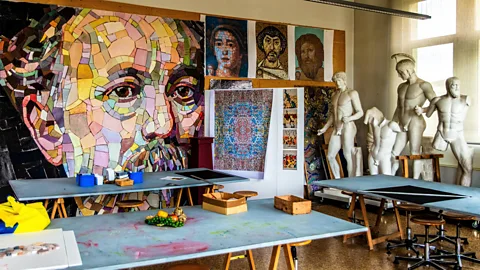
Founded in 1922, the school represents a commitment to excellence, craft, and cultural preservation. The school’s halls, workshops, and classrooms are more than just places of learning. They are living archives of an ancient art form that dates back to antiquity. Students from around the world come here to study the meditative discipline of laying tesserae — the tiny tiles that make up a mosaic. They work with the same focus and reverence once shown by Roman, Byzantine, and medieval artists.
The Quiet Craft of Mosaic Art
Step inside the school on any given morning, and the first thing you notice is the profound silence. It’s not the absence of activity, but rather the presence of focus. Gone is the clatter of a typical art school.In its place are soft sounds — hammers tapping and tiles shifting. It’s the quiet rhythm of a craft that requires complete focus.
The school is decorated in a way that echoes its legacy. Mosaics stretch across the floors, walls, and even ceilings. Students have recreated famous works like Picasso’s Guernica and Michelangelo’s Pietà using stone, glass, and enamel. These shimmering mosaics have been carefully assembled over decades. Each corridor is a gallery, and every step reveals a story.
Italy’s Secret Mosaic School: More Than Just a School
Unlike conventional academic institutions, the Scuola Mosaicisti functions more like a bottega, or artisan workshop, where students learn by doing. From the moment they begin the three-year course, students dive into real-world projects — some they create for private collections, others for public displays across the globe.
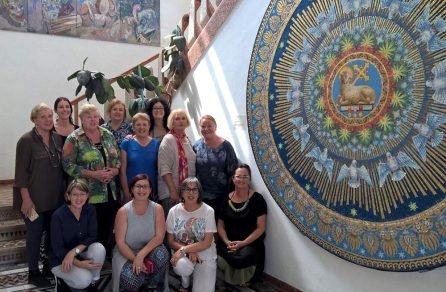
Each year, about 40 students are admitted, but only a select few complete the full program. Those who persevere earn the distinguished title of maestro mosaicista — a master of mosaics. The curriculum spans from Greco-Roman motifs to cutting-edge contemporary designs, all of it grounded in technique, history, and collaborative skill.
The Discipline Behind the Art
Mosaic-making, though visually stunning, is a discipline built on patience, repetition, and precision. Students place hundreds, sometimes thousands, of tesserae by hand. The task demands steady hands and a natural sense of rhythm, proportion, and balance.
Materials range from marble and smalto (colored glass) to shells and natural stones sourced locally from the Tagliamento River. Artists shape, cut, and assemble these raw elements to depict scenes from mythology, religion, nature, and modern life.
“The essence of mosaics is humility,” explains one instructor. “It’s a team effort. No single tile stands out, but together, they form something extraordinary.”
The History Behind Italy’s Secret Mosaic School
The roots of mosaic-making stretch back to Mesopotamia, with the art flourishing in ancient Greece, Rome, Byzantium, and later in Islamic cultures. Throughout history, mosaics have adorned temples, cathedrals, palaces, and modern buildings. Yet, while painting and sculpture often celebrate individual genius, mosaic has always celebrated collective skill.
This philosophy has been deeply ingrained in the DNA of Friuli-Venezia Giulia. With its proximity to Venice and a long-standing supply of natural stone, the region became a hub for mosaic art even as it waned elsewhere in Europe. Innovators like Gian Domenico Facchina, a native of the region, helped modernize the technique in the 19th century by developing a system that allowed mosaics to be assembled remotely and installed at scale.
Mosaic Art in Modern Times
Today, alumni of Italy’s secret mosaic school have left their mark worldwide — from the Paris Opéra Garnier to New York subway stations, from Jerusalem’s religious landmarks to installations in Tokyo. This quiet school in Spilimbergo has shaped some of the most recognizable public artworks on Earth.
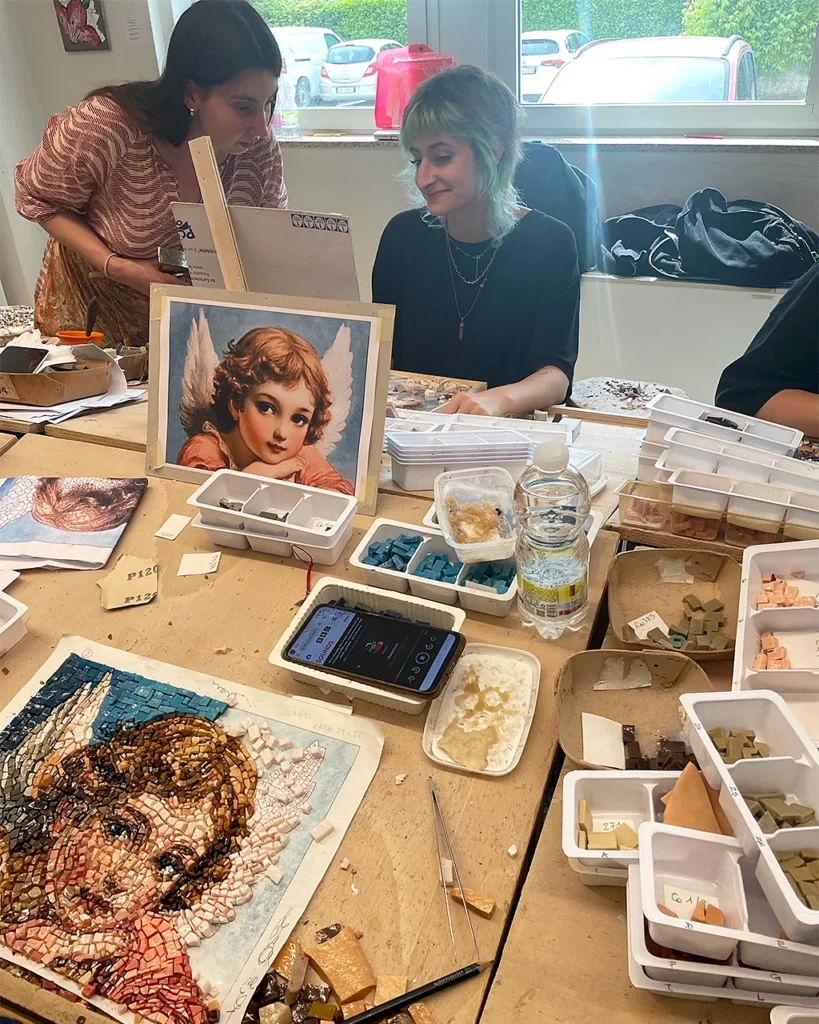
Current projects continue that legacy. A team of alumni and current students is assembling one of the school’s largest commissions — a sprawling 1,265-square-meter mosaic of local flora and fauna. They expect the piece to take over a year to complete. Once finished, it will decorate the school’s open courtyard.
Visiting Italy’s Secret Mosaic School: A Cultural Treasure
Though a functioning academic institution, the school is increasingly opening its doors to the public. Guided tours are available and provide access to more than 800 mosaic artworks, classroom visits, and historical archives. Trained guides — many of whom are locals — offer rich insights into both the craft and the context of the pieces.
Visitors can also sign up for short courses, ranging from weekend introductions to full-week intensives. These allow travelers to experience firsthand the meditative process of crafting a mosaic, from cutting the tesserae to placing the final piece.
Spilimbergo: An Open-Air Mosaic Gallery
The school is just one part of the mosaic experience in Spilimbergo. Throughout the town, mosaics can be found embedded in public walkways, decorating churches and restaurants, and displayed in galleries and boutiques. The Duomo of Spilimbergo, a grand Roman-Gothic cathedral, features intricate religious mosaics that echo the techniques taught at the school.
Shops along Corso Roma sell student and alumni creations, offering travelers a chance to take home a piece of Friulian craft. On the town’s edge lies Fabbrica di Mosaici Mario Donà, a historic workshop that creates the colored enamels used in traditional mosaics — open to visitors by appointment.
Nature as Inspiration and Material
Many of the school’s most stunning pieces take inspiration from the local landscape — particularly the stones of the Tagliamento River and the gravel plains of the Magredi region. These natural elements not only form the physical materials of mosaic-making, but influence its motifs: wildflowers, birds of prey, river fish, and forest animals.
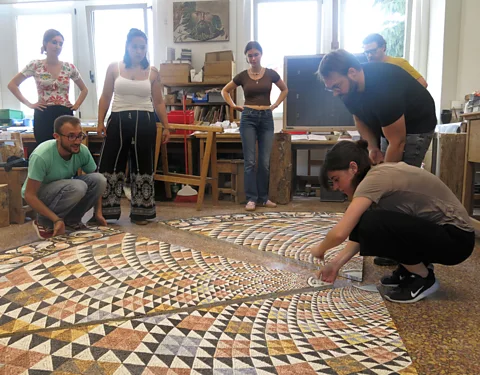
The connection between land and craft is one of the things that makes this school so unique. It’s not just about learning a technique, but understanding the history, ecology, and spirituality behind the materials.
A Global Draw for Artists and Art Lovers
Students come from all corners of the world — Germany, the United States, Japan, Brazil — seeking to immerse themselves in a tradition that combines art, architecture, and discipline. Some leave behind careers in marketing, engineering, or academia, driven by a desire to create something enduring and tactile.
For them, the school is both sanctuary and crucible: a place where they can shed distractions and engage in a practice that is as meditative as it is demanding.
Italy’s Hidden Artistic Gem
Italy’s secret mosaic school in Spilimbergo is far more than an art institution. It’s a bridge between past and present, a cultural anchor for the Friuli region, and a global hub for an art form that demands both patience and passion.
For those who discover it — whether through study, travel, or curiosity — the school offers not just knowledge, but transformation. In an age of speed and screens, it offers something ancient and essential: the joy of making, piece by piece, something beautiful and lasting.
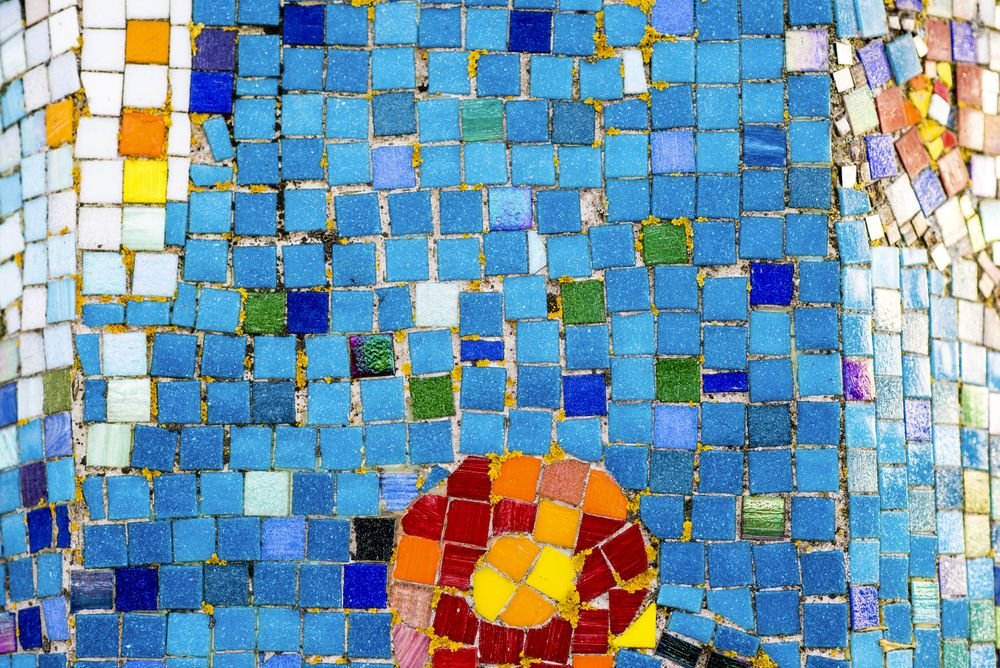




very informative articles or reviews at this time.
Very well presented. Every quote was awesome and thanks for sharing the content. Keep sharing and keep motivating others.